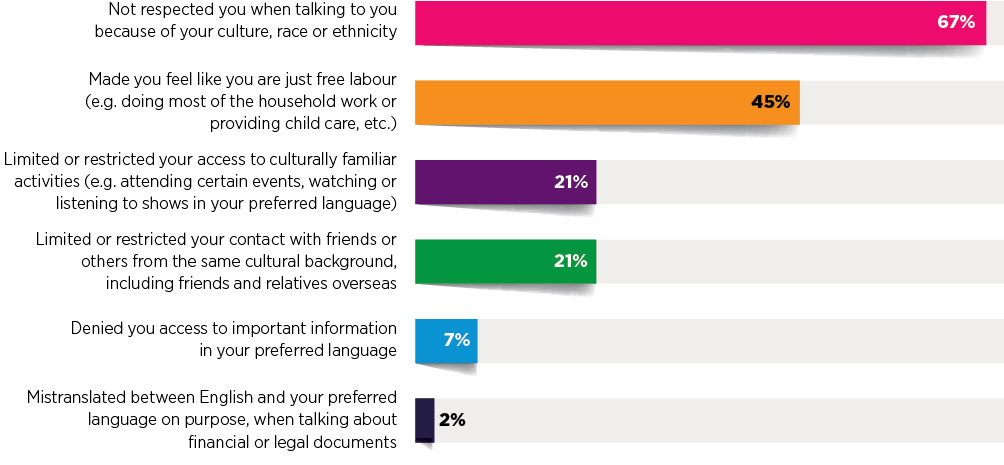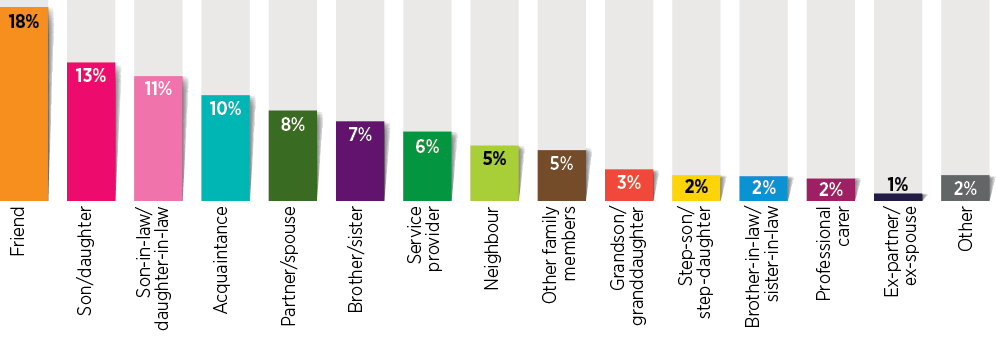Elder abuse in Australia: Culturally and linguistically diverse Australians
Findings from the National Elder Abuse Prevalence Study
Download Research snapshot
This snapshot discusses elder abuse and presents material that some people may find distressing. If you or someone you know needs assistance, please call 1800 ELDERHelp (1800 353 374). A list of elder abuse support services is available at the end of this snapshot. If you are in immediate danger call Police on 000.
Overview
The findings on the prevalence of elder abuse among older people with cultural and linguistically diverse (CALD) backgrounds were based on a subsample of participants who reported speaking a language other than English at home in the Survey of Older People. The prevalence of elder abuse for CALD participants was considered from two aspects: the overall prevalence of the five core subtypes (physical, financial, sexual, and psychological abuse, and neglect); and the prevalence of abuse relating to language and culture (here called the CALD-specific subtype).
How common is elder abuse among Australians with CALD backgrounds?
The Survey of Older People indicated that 15% of community-dwelling people aged 65 and older from CALD backgrounds reported an experience of at least one of the five core subtypes of elder abuse and CALD-specific subtype in the 12 months prior to the survey (Table 1). Fourteen per cent of CALD older people reported experiencing at least one of the five core subtypes, and 4% reported experiencing the CALD-specific subtype (with or without experiencing any of the five core subtypes).
The prevalence patterns across subtypes and overall were similar between the CALD and non-CALD groups.
| Type of elder abuse | CALD sample (%) | Non-CALD sample (%) |
|---|---|---|
| Financial | 2 | 2 |
| Physical | 2 | 2 |
| Sexual | 1 | 1 |
| Psychological | 12 | 12 |
| Neglect | 3 | 3 |
| At least one form of abuse reported (excluding abuse relating to culture and background) | 14 | 15 |
| Abuse relating to language and cultural background | 4 | .. |
| At least one form of abuse (including abuse related to language and cultural background) | 15 | .. |
Note: The difference in the prevalence between the two groups is not statistically significant for any of the abuse subtypes.
What are abusive behaviours relating to CALD backgrounds?
Of participants who experienced CALD-specific abuse in the past 12 months (Figure 1), the most common forms of abuse were not being respected when they were talked to because of their culture, race or ethnicity (67%) and being made to feel like they were just free labour (45%).
CALD older women were slightly more likely than their male counterparts to report an experience of at least one of the five core subtypes, though the difference was limited. There was no gender difference in relation to the CALD-specific subtype.
Figure 1: Participants who reported the CALD-specific subtype abuse, proportion reporting each item

Who commits elder abuse towards older Australians with CALD backgrounds?
Older people from a CALD background who reported an experience of abuse in the past 12 months provided information regarding the main perpetrators of this abuse. The `main perpetrator' of abuse referred to the person who was the only perpetrator of the abuse or to the perpetrator who affected the older person the most if there was more than one perpetrator.
- Most 'main perpetrators' of abuse towards older people from a CALD background were friends (18%) and children (13%).
Figure 2: Relationship of perpetrators to older people who experienced at least one type of abuse and are from a CALD background

Note: An older person may report more than one perpetrator in relation to an abuse subtype (core subtypes and CALD-specific subtype).
Support services/Helplines
- If you have any concerns about potential or actual elder abuse, please contact 1800 ELDERHelp (1800 353 374) to be redirected to the existing phone line service in your state or territory (free call).
- If you or someone you know have experienced violence or sexual assault and require immediate or ongoing assistance, contact 1800 RESPECT (1800 737 732) to talk to a counsellor from the National Sexual Assault and Domestic Violence hotline.
- For confidential support and information, contact Safe Steps' 24/7 family violence response line on 1800 015 188 or the Men's Referral Service on 1300 766 491.
- For a confidential discussion with an experienced counsellor, call Lifeline on 13 11 14.
Elder abuse in Australia: Prevalence
Elder abuse in Australia: Physical abuse
Elder abuse in Australia: Psychological abuse
Elder abuse in Australia: Financial abuse
Elder abuse in Australia: Sexual abuse
Elder abuse in Australia: Neglect
Elder abuse in Australia: Wills, powers of attorney and family agreements
Featured image: GettyImages/AfricaImages
Australian Institute of Family Studies. (2022). Elder abuse in Australia: Culturally and linguistically diverse Australians. (Findings from the National Elder Abuse Prevalence Study). Melbourne: Australian Institute of Family Studies.
Download Research snapshot
Related publications

Elder abuse in Australia: Sexual abuse
This snapshot provides key findings from the Survey of Older People (2020), a nationally representative survey of 7,000…
Read more
Elder abuse in Australia: Neglect
This snapshot provides key findings from the Survey of Older People (2020), a nationally representative survey of 7,000…
Read more
Elder abuse in Australia: Wills, powers of attorney and…
This snapshot provides key findings from the Survey of Older People (2020), a nationally representative survey of 7,000…
Read more